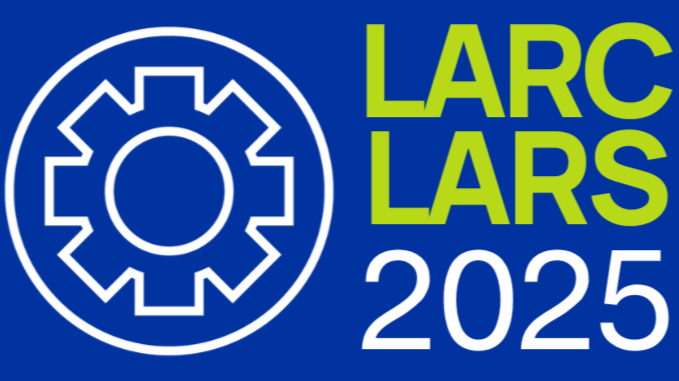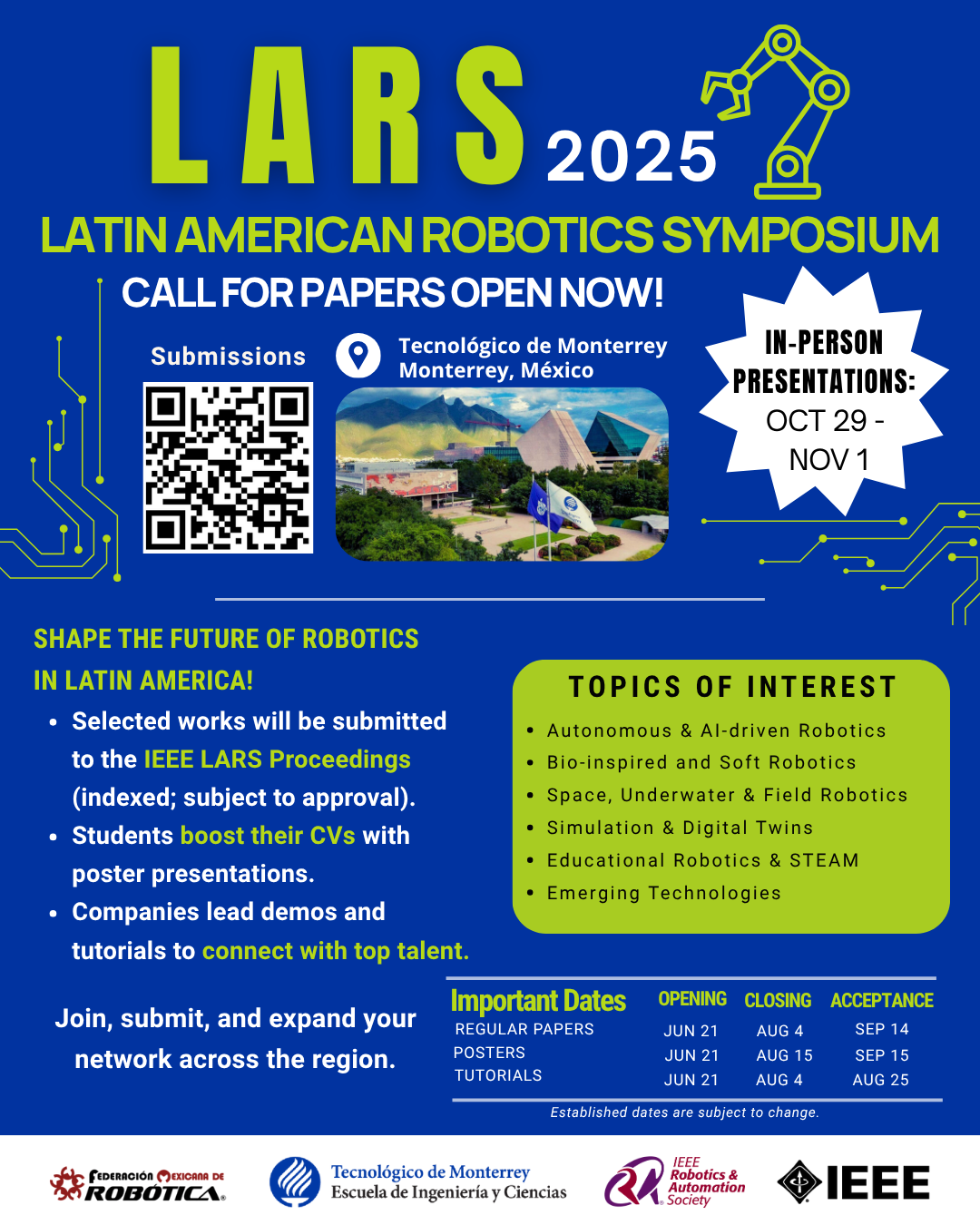
Latin american robotics symposium
Join us for the 22nd
From October 29 to November 1, 2025, the 22nd edition of the Latin American Robotics Symposium (LARS) will take place at Tecnológico de Monterrey, Campus Monterrey — bringing together leading researchers, emerging talent, and industry voices from across the region.
LARS is a unique opportunity to present original research, student posters, and applied case studies in a collaborative, robotics-focused environment. Whether you're investigating autonomous systems, designing novel platforms, or exploring education through robotics, this is where your work finds its audience.
Accepted papers will be submitted to the LARS Proceedings (indexed, subject to approval), while students can gain recognition and experience through poster presentations that elevate their academic path.
Beyond the talks and sessions, LARS features:
Hands-on workshops and technical tutorials led by experts
A public robotics expo with demos and installations
Networking nights connecting academia, industry, and future collaborators
Open Call for
Tutorials and Short-Courses for everyone
POster presentations for students
Regular Papers for researchers
LATE-BREAKING RESULTS POSTERS for everyone
check dates, topics, and guidelines
Topics of Interest
Autonomous Systems — navigation, planning, decision-making in dynamic environments
Robotic Perception — sensing, computer vision, sensor fusion, environmental awareness
Control and Planning — motion planning, control theory, adaptive and optimal control
Human–Robot Interaction — interfaces, collaboration, social interaction, shared autonomy
Multi-Robot Systems — coordination, swarm intelligence, distributed robotics
Learning and Intelligence — robot learning, reinforcement learning, cognitive architectures
Bio-Inspired Robotics — biologically motivated design and control, evolutionary approaches
Robotic Applications — industry, agriculture, healthcare, education, field deployment
Hardware and Mechatronics — design, actuation, embedded systems, novel mechanisms
Simulation and Software — digital twins, frameworks, testing, and reproducibility
Projects may include experimental studies, working prototypes, hardware or software development, simulations, theoretical analyses, or application case studies. We welcome contributions from undergraduate and graduate students, faculty members, and researchers involved in robotics and automation. Submissions that go beyond the topics listed above are also encouraged — for example, work related to ethics in robotics, educational tools, low-cost platforms, or novel uses of robotics in local or regional contexts.
Important dates
Deadlines |
Regular Papers Contributions
Submission
AUG 25th
Notice of Acceptance
Registration / Camera-Ready
SEP 22nd
OCT 10th
Student Research Posters
SEP 5th
SEP 29th
OCT 10th
Tutorials and Short Courses
AUG 25th
SEP 1st
—
Late-Breaking Results Posters
OCT 10th
OCT 19th
—
Author Guidelines
All submissions must be made electronically in PDF format and written in English. Submissions are handled through Microsoft CMT. To begin, authors must first create a CMT account:
By submitting a paper, authors commit that the final version will remain fundamentally consistent in length and content with the submitted manuscript, except for reasonable changes made in response to reviewer feedback. It is considered unethical to significantly reduce or weaken the final version compared to what was accepted.
Participation Requirements
To ensure your accepted work is included in the official program—and, where applicable, considered for publication in IEEE Xplore—the following conditions must be met:
For Research Contributions
At least one author must complete registration for the symposium.
The work must be presented in person as a 15-minute oral talk at LARS 2025.
For Student Poster Track
At least one author must complete registration for the symposium.
The poster must be presented in person as a physical poster at LARS 2025.
For Tutorials / Short Courses
At least one author must complete registration for the symposium.
The proposed activity must be delivered in person during LARS 2025.
Note: Applications for event scholarships to reduce registration cost for students will open soon (junior high-school, high-school, undergraduate and graduate).
“*Proof of student and/or member status to be provided upon request.“
**Bank charges may apply for money transfer.
***The registration includes 1 accepted article (6 pages maximum), 2 poster presentations, attendance to all conference sessions, keynote presentations, demonstrations and networking events
****The registrarion includes 2 poster presentations, demonstrations, keynote presentations (limited availability) and networking events
Submission of Regular Papers
Submissions must be written in English and follow the IEEE-RAS standard format. Each paper should present original and relevant work in theoretical, empirical, or applied research aligned with the symposium’s topics of interest.
Key submission details include:
Maximum length: 6 pages, including title, abstract, figures, tables, and references
Format: IEEE-RAS standard template, available here
Review process: Single-blind (author names are visible to reviewers)
File format: PDF only
Accepted papers will be presented in a 15-minute oral session at the symposium and must meet the participation requirements outlined in the Author Guidelines to be included in the final program and IEEE Xplore submission. Papers must be submitted electronically via the Microsoft CMT platform.
Submission of Student Posters
and “late-breaking results”
The LARS 2025 Poster Tracks invite students and professionals to share recent findings, preliminary results, or ongoing projects related to the symposium’s topics. This is a valuable opportunity to receive feedback and engage with the robotics community in a more informal and interactive format.
Please note: Poster submissions are not peer-reviewed and do not count as formal publications, but they will be made available to all conference attendees in both physical and electronic formats.
Key submission details include:
Poster language: English
Abstract requirement: Short abstract (1–2 paragraphs) describing the poster content
Extended Abstract (optional, only for Late-Breaking Results): A short manuscript highlighting the features of your work (2 pages maximum)
Poster format: Author-defined (no fixed template) — choose a layout that best represents your work
Poster size: Recommended size is up to 60” wide × 40” high (1.5m × 1m); maximum allowed size is 74” × 53” (1.8m × 1.3m)
File format: PDF (maximum file size: 2 MB)
Logo requirement: Include the LARS 2025 logo in the final poster
Presentation format: Printed poster to be presented in person during the poster session
Submissions will be screened by a panel for suitability. Accepted posters require that at least one author registers and is present in person to display and discuss the poster during the symposium. See the Author Guidelines for participation requirements.
Posters must be submitted electronically via the Microsoft CMT platform.
Submission of Tutorials & Short Courses
We welcome proposals for tutorials and short courses that offer engaging, high-quality content relevant to the symposium’s topics and to the broader Latin American robotics community. Proposals may target academic, professional, or educational audiences, and should aim to foster learning, collaboration, and participation.
Submissions will be evaluated based on:
The relevance and clarity of the proposed topic
The format and engagement potential of the session
The proposal’s attention to diversity, inclusion, and regional impact
Proposals that promote collaboration between academia, industry, and education, or are designed with the needs of the Latin American community in mind, are especially encouraged.
Proposal Format
Proposals must be submitted as a PDF, no longer than 12 single-column pages (or 6 double-column), and should include the following:
1. Basic Information
Title of the tutorial or short course
Type (tutorial or short course) and intended duration
Names, affiliations, email addresses, and websites of all organizers
Identify the primary contact person for correspondence
A link to a live website (if available) with information about the event
2. Summary & Description
A short description (max 200 words) for promotion on the LARS 2025 website
A clear overview of the topic, goals, and relevance
Details on content quality, participant engagement, and expected outcomes
The format (e.g., presentations, panels, breakout groups, interactive tasks)
Whether and how remote participation will be supported (e.g., Zoom, live stream)
Target audience and prerequisites or background knowledge required
Experience with previous tutorials or similar events (if applicable)
3. Schedule & Speakers
A tentative schedule with session structure
List of confirmed invited speakers (if any), including diversity efforts in speaker selection
It is strongly recommended to include email confirmations from speakers as an appendix
Additional Planning Sections (each max 500 words)
These sections help evaluators understand your preparation and outreach plans:
Participant Outreach Plan — How will you attract relevant participants beyond standard announcements? Include past experience and expected attendance if applicable.
Interaction Strategy — Steps to encourage active engagement and sustained participation
Dissemination Plan — How materials and outcomes will be made available (e.g., online archive, recordings, open materials)
Diversity & Inclusion Plan — Actions to ensure diverse and inclusive engagement before, during, and after the event
Final Requirements
A statement confirming that organizers will attend in person and that the session will comply with the RAS Guidelines
A statement acknowledging the IEEE RAS Code of Conduct
(Optional) List of additional equipment needs beyond a projector and screen
(Optional) A recommendation letter from an RAS Technical Committee (not required but encouraged)
“The Microsoft CMT service was used for managing the peer-reviewing process for this conference. This service was provided for free by Microsoft and they bore all expenses, including costs for Azure cloud services as well as for software development and support.”








